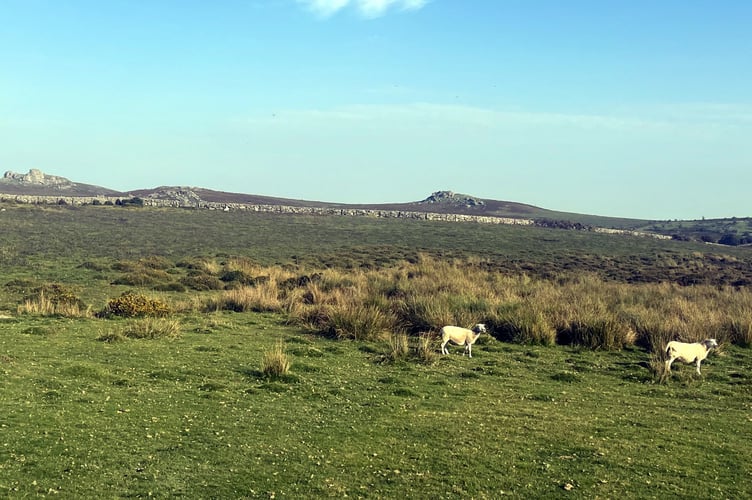AS the government’s independent review of Dartmoor’s controversial SSSI grazing payments enters its final stages before publishing, the future path of Dartmoor hangs in the balance.
Although most are in agreement that many ecosystems on Dartmoor are in decline, two conflicting narratives on what’s happened to these ecosystems have led to two very different conclusions as to what remedy is needed.
Natural England says that they do not want to end farming on the moor, but rather ‘deliver the right conditions by putting the right stock in the right place at the right time of year.’
However many farmers say that Natural England’s plans would have devastating consequences, not just for moorland ecosystems, but for people’s livelihoods, culture and way of life.
Farming on Dartmoor has always been a challenging pursuit, but for over 5,000 years it has been the main land use for the park. Working and re-working the land, farmers have created and maintained a large part of the Dartmoor landscape.
Today over 90% of the land within the National Park boundary is used for farming. Much of this area is both open and enclosed moorland where livestock is grazed, and the remainder is made up of fringe enclosed farmland which mainly comprises improved grassland.
Given its unique environment, Dartmoor is peppered with areas known as Sites of Special Scientific Interest (SSSI). A formal conservation designation, SSSIs usually describe an area that’s of particular interest to science due to the rare species of fauna or flora it contains.
However, earlier this year, Natural England (NE), the body that represents Defra, published a blog post explaining that many of Dartmoor’s Sites of Special Scientific Interest (SSSI) were in decline, despite ‘huge investment’ through agri-environment schemes since the 1980s.
Following the blog, NE proceeded to send letters to the 900 Dartmoor farms that sent shockwaves throughout the community. The letters detailed new requirements for those farming Dartmoor as their 10-year agri-agreements came to an end.
It outlined much stricter grazing regulations for farmers in the agri-environment schemes, which would remove livestock from the moor almost entirely during winter, and see dramatically lower grazing throughout summer.
At a Commons Debate in April, Sir Geoffrey Cox, MP for West Devon and Torridge said that this news ‘was the equivalent of exploding a metaphorical bomb within the small and fragile communities that the moorland hosts.’
Sir Cox added that ‘not a single organisation on the moor was consulted.’
Stocking levels on the moor are already at comparatively low levels to what they once were, and it’s unclear how much lower they can go before making a living on Dartmoor’s rugged uplands becomes unviable.
Helen Radmore’s farm sits near Burrator Reservoir on southeast Dartmoor. As well as being a dedicated farmer, she also works to protect tenant farmers’ interests through the Tennant Farmer Association. ‘Most of the stock disappeared 25 years ago,’ said Helen, ‘more restocking will end people’s businesses, their livelihoods.
‘It feels like farmers on Dartmoor, particularly tenant farmers are being airbrushed out of the system.’
Dave Slater, Regional Director for Natural England South West, explained: ‘SSSIs which contain our most precious examples of wildlife and biodiversity, and the government’s Environmental Improvement Plan commits us to restoring 75% of our SSSIs to favourable condition by 2042.
‘Our assessments found clear and extensive evidence of the need to review grazing management across several commons on Dartmoor.’
Wesley Smyth, NE’s Deputy Area Director, added: ‘If enter an environmental management scheme, you accept the funding to deliver the outcomes. And if people aren’t delivering on what they’ve signed up to deliver and they’re accepting public money for doing that, it’s right that it’s questioned.’
Following the Commons Debate in debate in April, it was agreed that an independent review of the management of Dartmoor should take place before any major changes.
The review, due to be published at the end of the month, examines the existing ecological evidence and ‘reviews any lessons learned from previous approaches’, before making recommendations to the ‘most effective grazing and management regime(s) that would deliver improvements on the SSSI sites across Dartmoor.’
These recommendations, however, will: ‘Balance the long-term and sustainable delivery of other priorities such as agricultural production, public access and cultural and natural heritage.’
While both parties recognise that change is needed on the moor if the ecosystems are to thrive in any meaningful sense, options differ wildly on how to get there.
Mr Smyth said: ‘Nothing is black and white, but our view is that the current management is the most significant effect factor in impacting condition. And we feel we’ve got a really strong evidence base to demonstrate that.’
With the impacts of both undergrazing and overgrazing present, farmers worry that destocking the moor or radically changing the grazing patterns will have devastating knock-on effects.
The knock-on consequences for many species, such as the dung beetle and many species of bird from going too far, or not far enough, will be profound.
Helen said: ‘I just think we’ve ended up with a lot of ideology instead of true ecology. NE rely so much on their SSSI surveys and don’t look at Dartmoor as a whole ecosystem.
‘If you suddenly decide to leave the moor, a dominant plant will take over, and if you add in the fact that we’ve got climate change, nitrogen deposition and other factors you’ll end up with huge undergrazed areas and overgrazing in places where the few livestock remaining can get to.
‘If you continually ask us to take stock on and off the commons, that livestock’s heft is damaged. They’ll wait next to the moor gate and walls to come in.’
Helen worries that this will lead to most areas of the moor being severely undergrazed with a monoculture of dominant species, such as molonia grass, while all animals will stay near the farm or in areas where they can get palatable food.
A build-up of molinia grass and other species such as gorse has turned Dartmoor into a tinderbox. Helen said: ‘We might be deluged with water at the moment but you can bet your bottom dollar that come summer, the fuel load will be incredible up there. And if tenant farmers leave, we’ll have no fire parties up there either.’
Soon the fate of the moor will be sealed when action is taken under the recommendations of the independent review. While a major upheaval could be on the cards, Wes Smyth was optimistic.
‘Farmers are, in my experience, incredibly flexible and adaptable. And what you see in farming now looks different from what it was just two decades ago. It’s not a static thing. And I think farmers have always sort of been innovative in seeing how they want to develop and progress their businesses. And there are examples on Dartmoor itself about how you can work with agri-environment schemes and have a sustainable farming future.’
Farmers, on the other hand, are less positive about the future of the moor and their livelihood. Helen said: ‘Most people are pessimistic. People up here have a generational passion for the moor and if you extinguish that now, it may never return.
‘I think it’s been a one-way street of imposing what they feel is best for us yeah or best for the Dartmoor while most farmers feel undervalued for what they do.
‘We just get spouted the SSSI legislation, and NE must improve its good condition. Well, from a farmer’s point of view, we look at them and say, well, you’ve had the last 25 years to do that, and to be quite honest, you haven’t done a very good job.’





Comments
This article has no comments yet. Be the first to leave a comment.